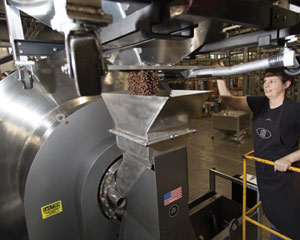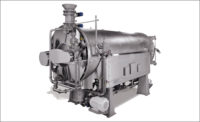Established in 1996, Kicking Horse Coffee of Invermere, BC has been the best-selling Fair Trade Organic coffee in Canada for 13 years, according to A.C. Nielsen. The gourmet coffee maker selects only Arabica beans, from which it produces 11 single-bean varieties and seven different blends for roasting, with a total trade volume of approximately 60,000 lb. a week.
But Kicking Horse faced a quality control issue with the whole roasted beans that are blended together; the wire-type batch blender the company used to mix the beans damaged them during the blending operation.

|
|
Munson Machinery’s rotary batch mixer helps Kicking Horse Coffee produce its coffee bean blends in a wider range of batch sizes without damaging the beans, and with full discharge from the vessel. Source: Munson Machinery. |
“Broken beans have increased surface area, and this increases their exposure to oxidation. A whole bean speaks to the quality of the bean,” says Tom Hoyne, manager of the roasting department. As the bean is roasted to different degrees of darkness, its bulk density varies greatly. A darker roast yields a more fragile bean that is more susceptible to breakage, adds Hoyne.
In addition to bean damage, the wire-type blender did a less-than-adequate job of discharging the beans at the end of the blending operation. Approximately two pounds of beans had to be removed manually each time a batch was run. Consequently, Kicking Horse was limited to producing only small batches of blended beans with the wire blender to prevent bean damage, and the blender could only start after the hopper was fully charged.
When Kicking Horse decided to replace the wire-type blender, it selected the 700-TS-110-SS rotary batch mixer from Munson Machinery Co. Inc. Unlike the wire blender which only turned and agitated the roasted beans, the Munson batch blender delivers tumble, cut, turn and fold mixing actions that assure thorough blending without damage to the fragile beans.
The tumbling action is due to the continuous rotation of the drum while specially designed lifters within the drum continuously cut out portions of the batch and folds them back into the center of the blend. “As displaced beans move toward the outer edge of the mix and come into contact with the drum wall, they are gently folded back into the main body of the batch,” says Hoyne.
The Munson rotary batch mixer rotates during loading, so Kicking Horse does not have to wait until all the beans are loaded for the mixing process to begin, and there is no stratification (separation) of the different bean types in the blend.
“Mixing time is two minutes regardless of the size of the batch, the bulk density of the bean or the number of different types of beans being blended,” states Hoyne. The flexibility of the Munson mixer allows Kicking Horse to run batches in sizes from 780 to 2,600 lb., a range about five times greater than was possible with the wire mixer, according to Hoyne.
Once blending is completed, the drum continues to rotate, and the lifters direct the contents toward the discharge spout. This action prevents stratification of the beans by density while completely discharging all the contents from the vessel. “Because the blender does not cause dust or particle formation and discharges 100 percent of its contents, manual labor is not needed to empty the vessel, and the vessel requires less frequent cleaning.” Kicking Horse cleans the blender once a week using a biodegradable surfactant to remove any oils that may have accumulated on the inside surface.
For more information:
Steve Knauth, Munson Machinery Co. Inc., 315-797-0090, sknauth@munsonmachinery.com





